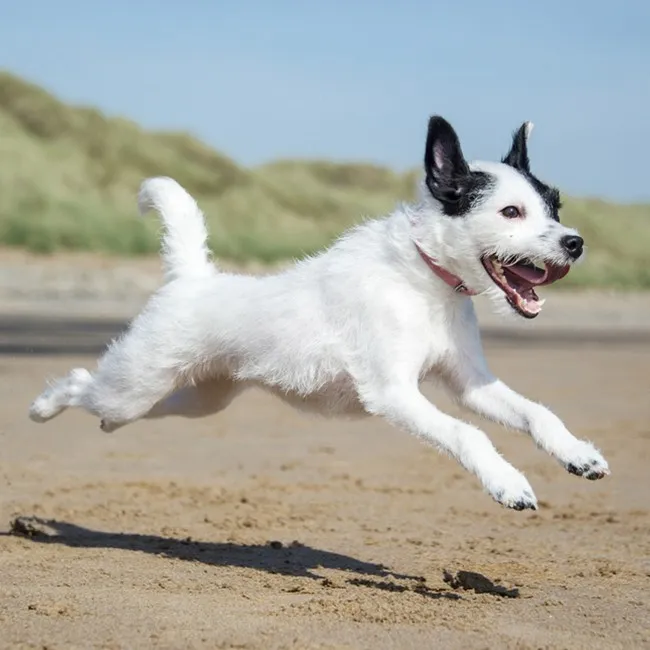BONE & JOINT HEALTH
How To Manage Arthritis In Dogs In Colder Weather | Animigo
How To Manage Arthritis In Dogs In Colder Weather
While winter and cold weather can be the favourite time of the year for many of us, for those with arthritis, the chilly temperatures can be quite worrisome. The dampness and harsh cold weather in winter tend to lead to joint pains and stiffness, sometimes making even small movements a challenging task for your arthritic dog. So, understanding the difficulties that cold temperatures can bring for your arthritic furry friend, is the first move toward providing them with the care they need. Wondering how to help a dog with arthritis at home?
In this blog, we will discuss how colder months can intensify the signs of arthritis in dogs and provide you with practical tips for caring for your arthritic dog in cold weather. From home therapies to joint care supplements, we will explore multiple ways in which you can help your furry companion manage their arthritic pain better.
How Does Cold Weather Affect Your Dog’s Joints?
Before learning about the various practical methods of dog arthritis treatment, it’s important to understand how cold weather can impact the joints of your arthritic dog. Cold weather can have an adverse effect on dog’s joints, especially if they’re struggling with arthritis. A steep fall in temperature can not only worsen joint inflammation but also intensify joint stiffness, pain and associated discomfort, making movement tougher for arthritic dogs. Some of the common reasons why cold temperatures affect arthritis in dogs are:
- Change in air pressure - Since atmospheric pressure falls in the winter, joint tissues start expanding. This further aggravates the joint ache in arthritis dogs.
- Winter lethargy - Just like us humans, animals also tend to be less active in cold weather, which can worsen their joint stiffness and pain.
- Thickening of joint fluid - The joint fluid, which supports flexible movements, thickens under cold temperatures, thereby obstructing easy movements.

5 Tips for Dealing With Arthritis in Dogs in Colder Weather
Arthritis in dogs can be mild, moderate or severe, depending on their age and joint pain intensity. No matter which stage of arthritis your dog is in, you must take measures to alleviate their pain right from when it’s detected. For initial or end-stage arthritis in dogs, here are some practical tips that can help you take care of your furry friend in cold weather.
Keep Them Active
Regular exercise is crucial if you want to prevent your pooch’s arthritis from getting worse. Going out on walks daily or engaging them in indoor activities can keep them mentally and physically active. This can help your dog keep their joint stiffness and winter lethargy at bay. You can also take your pooch out for a play date with their furry friends, encouraging them to interact, play and stay active. If you’re already noticing major signs of arthritis in dogs like joint pain, limping while walking, difficulty in jumping, etc., you can consider walking your dogs around your own house. This is because exposing arthritic dogs to extremely cold temperatures can make things go downhill for them.

Warm up the Surroundings
Not only us humans, but our furry friends too like to snuggle in a cosy place in cold weather. Especially for treating arthritis in dogs, heat and warmth can be major allies. Keeping your pooch in a warm ambience can help soothe their achy joints and provide them with the immediate comfort that they deserve. If you’re wondering how to help a dog with arthritis at home, then try to provide your dog with a warm, cosy bed by adding extra blankets and padding. You may also try heated pads for additional warmth and support for their joints. Make sure you place their bed away from cold surfaces to avoid things from getting chilly. Even when you take them out for walks, you can put a warm dog jacket on your furry friend to alleviate their joint pain.
Keep a Check on Weight
Since dogs tend to be less active in cold weather, winter weight gain is common among canines. The problem is that more weight will put more pressure on their joints, resulting in more severe joint pain. So, it’s important to frame your dog’s diet strategically and manage their weight in winter. Prioritise protein-rich foods for your pooch to promote lean muscle growth and avoid carbohydrate-heavy foods to avoid unwanted weight gain. Make sure you measure your pet’s food portion size during every meal to avoid overfeeding them. For treating arthritis in dogs who are already obese, you can seek professional advice from a veterinarian to help you chalk out a proper weight loss diet plan for your pet.
Opt For Alternative Therapies at Home
When you start noticing symptoms of arthritis in dogs’ hind legs and forelegs, try some alternative therapies at home to stop the pain from worsening. Massage, acupuncture, water therapy, heat therapy, laser therapy, etc. can provide some relief and eventually reduce the pain. From these alternative methods, you can get any therapy for dogs with arthritis done by specialised practitioners. However, you may also learn some massage techniques from the experts and try them on your furry companion at home. Veterinarians often suggest making your arthritic dog wear a heated coat throughout the day as a home remedy for soothing their aches. Sometimes these alternative therapies have such a positive effect on arthritic canines that no further medications are needed for the treatment.
Try Joint Care Supplements
If you're looking for a way to do dog arthritis treatment at home, then joint care supplements can be one of the most effective solutions for your arthritic pet. But which joint health supplement is right for your pooch? While choosing a joint care tablet or powder, always choose the one that’s made from natural and cruelty-free ingredients to ensure your pet doesn’t encounter any harsh side effects. Active natural ingredients like Turmeric, Hyaluronic acid, Glucosamine and Chondroitin are known to help ease the joint ache, prevent joint stiffness, support mobility and promote bone strength. You can also consult your veterinarian to assist you in picking up a safe and effective joint care supplement for your dog.

The Final Takeaway
Now that you have some practical tips up your sleeves about dog arthritis treatment, it’s time to give your pooch the comfort and support they need during colder months. If your dog’s arthritic pain gets worse and nothing seems to help, then we would highly suggest you visit a veterinarian and seek personalized therapy for dogs with arthritis. Vets often suggest joint care supplements for arthritic pets. At Animigo, we have a wide range of joint health supplements formulated specially to cater to the needs of your pet’s bones and joints. What are you waiting for? Implement the above-mentioned tips and methods and help your pooch enjoy a pain-free winter.





